The Interacting Galaxy Pair
Arp 285 (NGC 2856/4): SDSS, Spitzer, GALEX, and SARA Images
From
Smith et al. (2008),
`Stochastic `Beads on a String' in the Accretion Tail of Arp 285',
Astronomical Journal, 135, 2406.
For appendix material, click here.
This is one of the galaxies
in the
`Spirals, Bridges, and Tails'
Interacting Galaxy Survey, published in
Smith et al. (2007), Astronomical Journal, 133, 791.
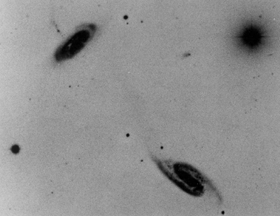
Optical image of Arp 285 (NGC 2856/4) from the
Arp Atlas of Peculiar Galaxies (1966).
North is up and east to the left.
This is a widely separated pair. The northern galaxy NGC 2856 has an unusual
`tail' like feature extending out perpendicular to the disk
from the middle of the disk.
Toomre and Toomre (1972) suggested that this is
material from bridge/companion,
accreting to NGC 2856. Note that the Arp image shows clumpiness
in this tail.
Arp 285 is at a distance of 39 Mpc (H0 = 75 km/s/Mpc; v = 2898 km/s).
The
VLA 21 cm HI maps of Arp 285, from
Chengalur
et al. (1994).
Note that the
tail to the northeast is
rich in HI.
The left panel is the naturally-weighted map, with a resolution
of 29". The right panel in the map with uniform weighting, with 12"
resolution.
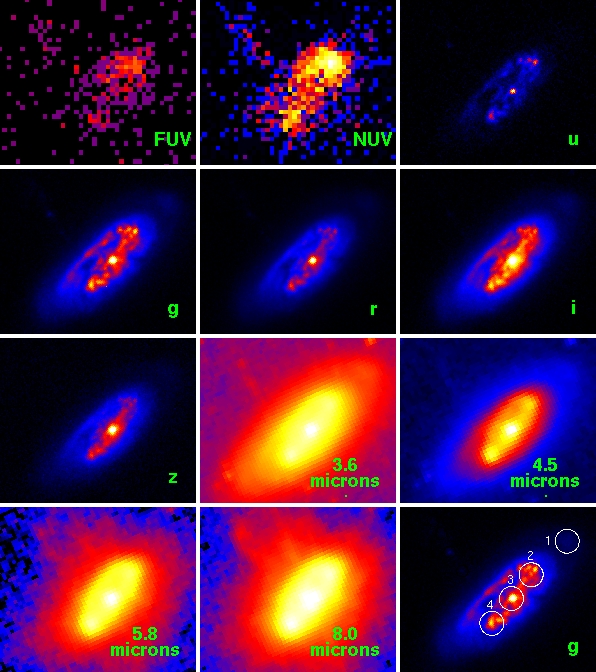
A montage of the northern galaxy NGC 2856 in the GALEX, SDSS, and Spitzer bands.
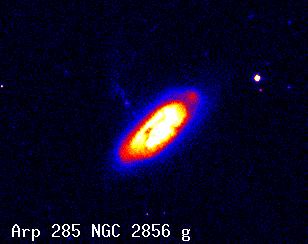

Another look
at the SDSS g and
r images of NGC 2856, with
a different display stretch. Four approximately
evenly spaced clumps are visible along the
northern tail
in all of the SDSS images, except for
the z image (longest wavelength
SDSS data) and the u image (for two clumps).
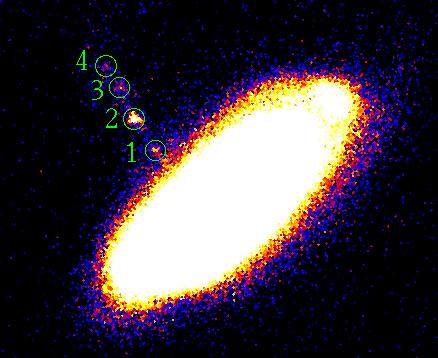
The clumps in the tail are identified in this g band figure.
They were selected by eye based on the g band image.
The circles have radii of 5 pixels (1.61 arcseconds).
Clumps 1 and 2 have bright compact cores; clumps 3 and 4 are fainter,
with multiple peaks
in the vicinity.
From south to north, the
separations between the clumps are
6.1" (1.2 kpc), 5.5" (1.0 kpc), and 4.1" (0.8 kpc).
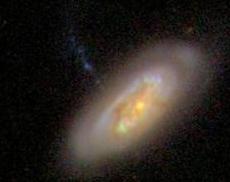
The SDSS color map of northern galaxy NGC 2856.
The tail clumps are
bluer than main disk of NGC 2856 in the optical.

The tail is also clearly detected in
the GALEX images, however,
with the low resolution
of GALEX (~6"),
it is
hard to distinguish individual clumps.
Left: the NUV image,
from the GALEX MIS survey.
This exposure was 813 seconds.
Right: the FUV image, from the GALEX All-Sky Survey.
This exposure was only 112 seconds.

The SARA H-alpha and R images of NGC 2856. The H-alpha is superimposed
on the 8 micron and SDSS g images in the last two panels.
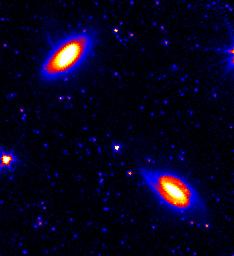
The 3.6 micron Spitzer image of Arp 285.
Note that the northern plume is visible.
These data were previously published in
Smith et al. (2007), Astronomical Journal, 133, 791.
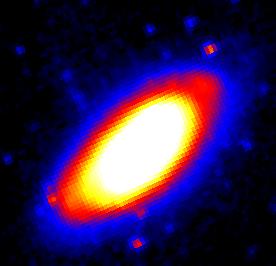
An expanded view of the 3.6 micron image of NGC 2856.
Note that clumps 2, 3, and 4 in the SDSS image are also
visible at 3.6 microns.
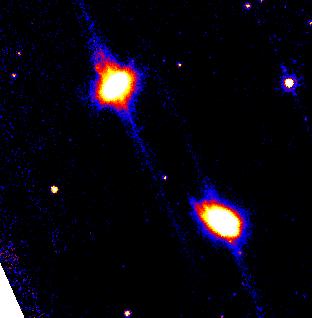
The 8.0 micron image of Arp 285. Note the bad `banding' problem
that
is present in this image.
Note that clump 3 in the the northern plume *is* visible,
however,
it is
unfortunately
very
close to a 'band'.

A zoomed in view of NGC 2856, at 8 microns. Note that
clump 3 in the SDSS data is very bright at 8 microns.

Left: the Arp 285
8 micron image, after
the banding has partially been corrected
for
using
the
IDL routine
`fixband'.
Right: the original 8 micron image. Although the
bad `band' is still visible in improved image, it is much less obvious.

Arp 285 was also observed at 24 microns with
MIPS, but the image (shown above for the northern
galaxy NGC 2856) is not suitable for getting
clump or tidal fluxes
because of artifacts
from the point spread function.
See
Smith et al. (2007), Astronomical Journal, 133, 791
for more details.
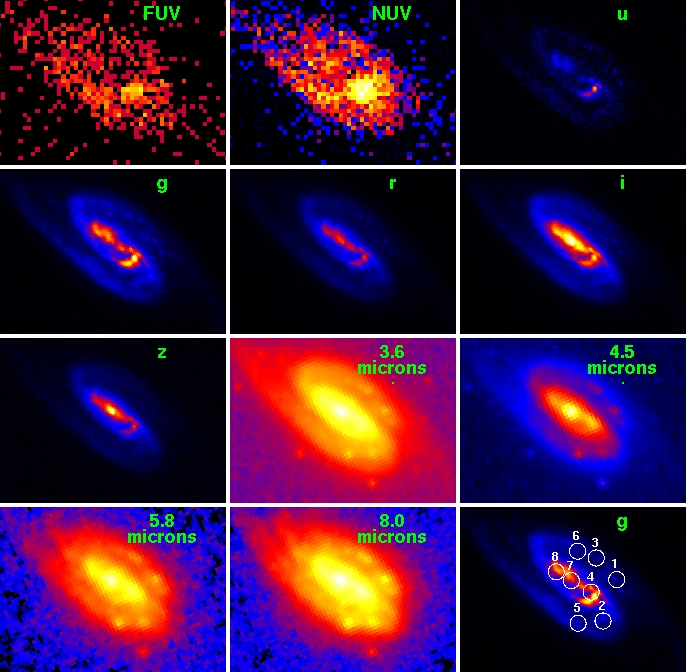
Montage of the southern galaxy NGC 2854
in the GALEX, SDSS, and Spitzer bands.
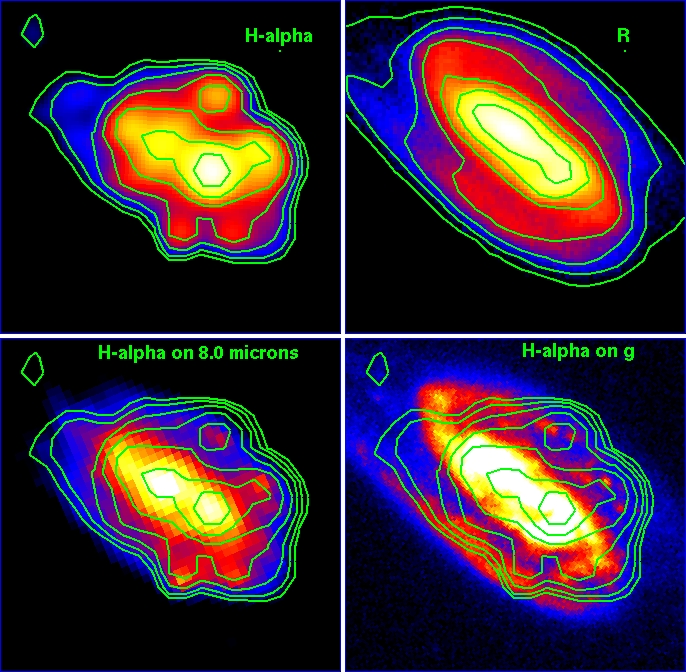
The SARA H-alpha and R images of NGC 2854. The H-alpha is superimposed
on the 8 micron and SDSS g images in the last two panels.
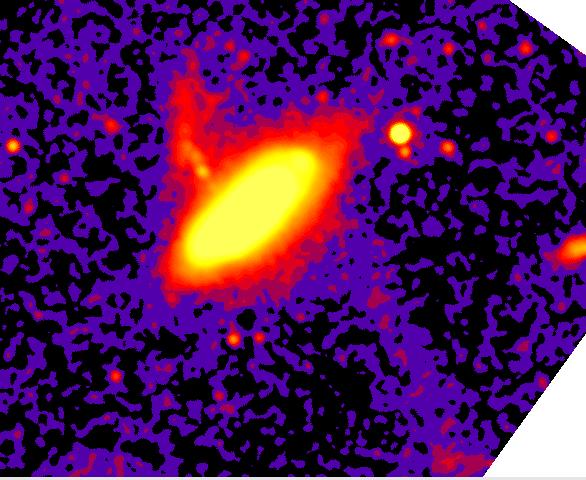
The smoothed NGC 2856 g SDSS image.
A full connecting bridge is visible in the smoothed g and r images,
but not in u, i, or z.
To return to Beverly Smith's web page, click
here.
To see more results from
the `Spirals, Bridges, and Tails' Interacting
Galaxy Survey, click
here.
Last updated: 5/15/08.

















